|
|
Post by htmb on May 16, 2013 22:10:24 GMT
Loving it all! Every picture is interesting, but for some reason I found the river picture fascinating. It made me wonder what might be under the surface.  |
|
|
|
Post by nycgirl on May 23, 2013 14:30:48 GMT
Thank you everyone once again for your kind comments and your indulgence. I'm finally close to wrapping up this part of the trip. I did warn it would take me a long time.  |
|
|
|
Post by nycgirl on May 23, 2013 14:50:51 GMT
We headed for Kaokoland, a sparsely populated wilderness in northern Namibia. My main goal was to visit the Himba, one of the last strictly traditional tribes in Africa. Along the way, we kept our eyes peeled for cheetahs and the rare desert-dwelling elephants. No such luck, but we tried.  We did have a very serendipitous sighting, however. While driving down the road, a flurry of small, brilliant green birds flew from a tree as we passed it. We pulled over and got out of the car and, although the birds had now landed in trees quite a distance away, my husband immediately identified them as rosy-faced lovebirds. He was very pleased because he had had a lovebird as a kid and he was hoping to see them in the wild. We left the car and followed them to get a closer look, but the nervous little things took off as we approached. We continued to tail them and they led us to a sandstone koppie where the whole colony was nesting.  There were about a hundred of them, nesting in the tiny rock crevices and chattering away in high-pitched chirps. So cute. We spent a few minutes watching them, then left them in peace.   The next day we drove to the Otjikandero Himba Orphan Village, a farming settlement founded to support orphaned or disadvantaged Himba children. We met up with our guide, who explained the work that they do and taught us a greeting and a few other basic phrases in the Himba language. Upon entering the village, we were introduced to the women who take care of the children, some of whom have children of their own, and told about their traditions. The women have a very distinctive look due to their custom of applying otjize, a mixture of red ochre and butter fat, to their skin and hair. They wear leather headdresses that represent their marital status.  The women spend a lot of time on their beauty regime. Their hair is sectioned into braids and covered with otjize and the ends are left in tassels. As we chatted with each other, with the guide translating, they asked me about my hair, which was auburn at the time. I explained to them that I had dyed it to look like that. It goes to show that despite our differences, both of our cultures value style and grooming as a form of self-expression. 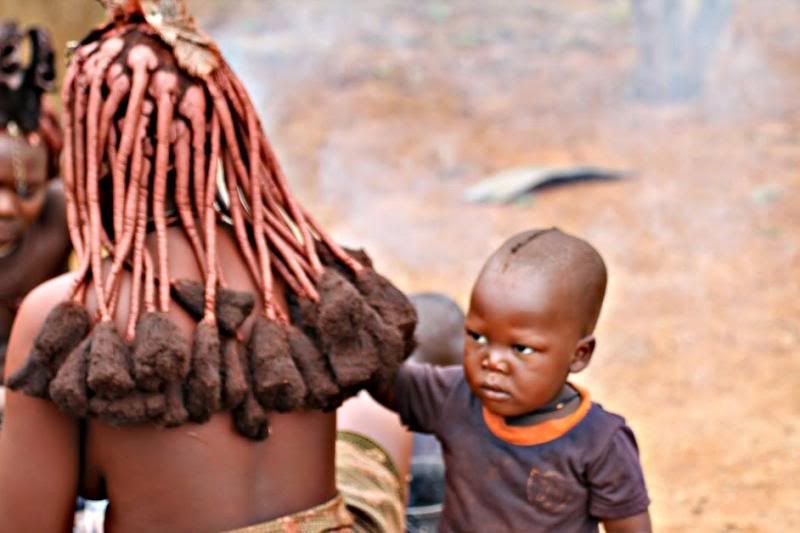 The children wear their hair in one or two plaits.  All of the Himba, including the children, wear jewelry that they craft themselves.  Jewelry often conveys information about the person wearing it. This 17-year-old girl wears a necklace that indicates that she is childless.  They are very creative with the materials they have available. The beads on these anklets were made from wire fencing.  Although the Himba have managed to preserve the traditions of their ancestors and eke out a living raising cattle, some children do decide to leave the village and adopt a Western lifestyle. This girl is going to school to become a veterinarian.  The Himba live in huts made of saplings, mortar composed of clay and dung, and straw for the roof.    During our visit, the Himba were fine with being photographed as they went about their daily routines.  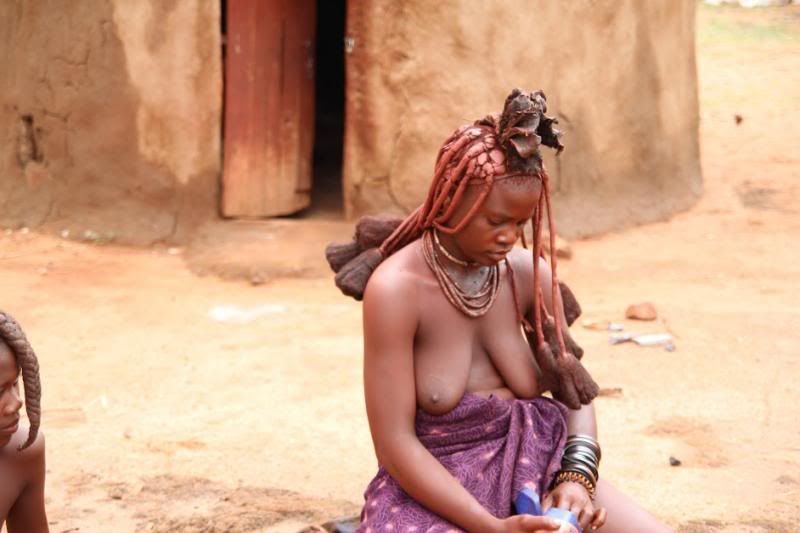 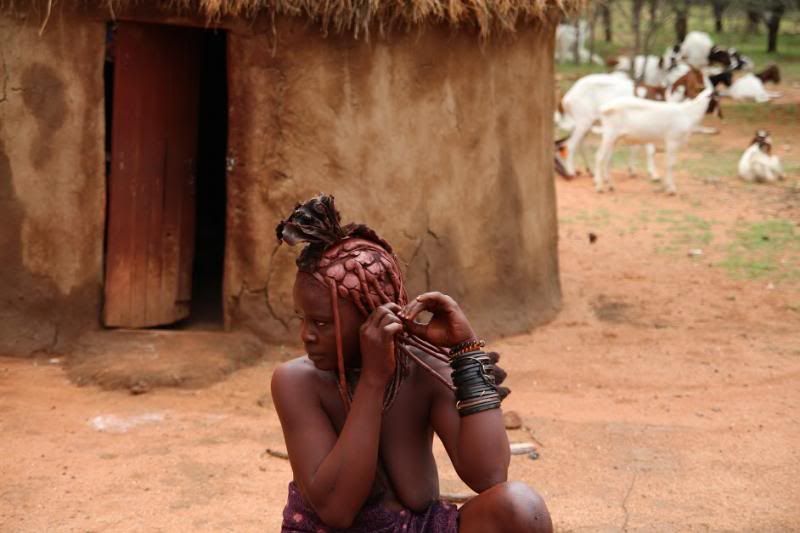   The children amused themselves with their imagination and whatever was handy, like all children do.    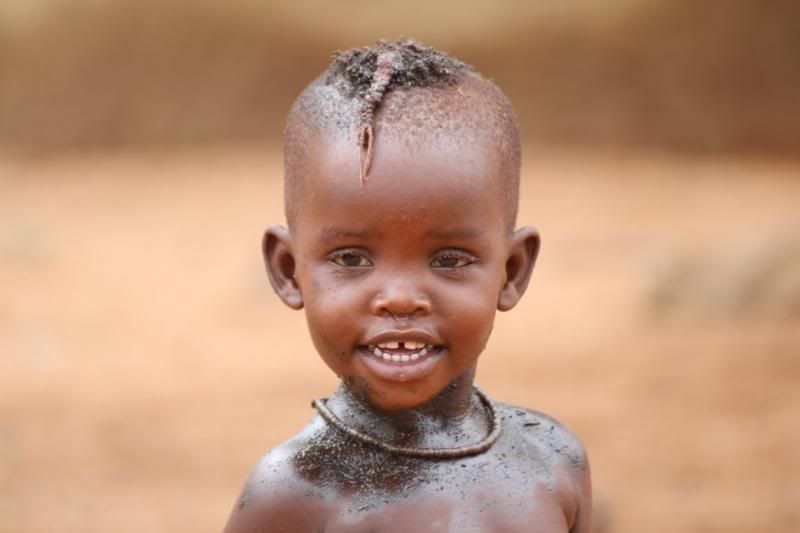  It’s funny, but as I watched the kids playing some kind of jumping rope game, it brought back memories that I’d almost forgotten of playing similar games when I was little. I remember trying to perform some feat on a rope held between two kids, and successful completion meant having to do increasingly difficult moves. I sometimes used a pole or tree if I only had one playmate around.   Some kid had engineered a pretty neat little truck using wire and bottle caps. It reminded me of the wire art I had seen in South Africa.  |
|
|
|
Post by bixaorellana on May 23, 2013 17:10:49 GMT
I'd have said it was impossible for you to add anything to this thread that was as dazzlingly as what you've already shown, but I'm thrilled to be proven wrong.
The birdy pics are adorable. How cool that you followed them on foot & they let you see where they lived.
The Himba village is infinitely fascinating. Since you all were introduced to the nursery school part of village life, does that mean everyone else was off in the fields? Is the man in modern dress (right below the photo of the hut saplings) your guide?
Obviously I'm saying this from the vantage of my cultural background, but the girl who's studying to be a vet looks happier than the other women. All of your portraits are really, really, really wonderful.
|
|
|
|
Post by tod2 on May 23, 2013 17:23:58 GMT
Incredible incredible photos! You saw beyond the 'click click click' of a tourist camera and did some stunning work with your photography - congratulations!
Looking forward to Kruger........
|
|
|
|
Post by nycgirl on May 23, 2013 17:57:01 GMT
Thank you so much! Although I do have to give my husband credit, he took most of this set. Since you all were introduced to the nursery school part of village life, does that mean everyone else was off in the fields? Is the man in modern dress (right below the photo of the hut saplings) your guide? Obviously I'm saying this from the vantage of my cultural background, but the girl who's studying to be a vet looks happier than the other women. I don't know how many people live there, but I imagine there's a lot of herding, gathering, hauling water, and other stuff to do. No, that man's not our guide but I do have a picture coming up. From what I understand, all of the grown men prefer to wear Western clothes even if they live mostly traditionally. About the student, maybe her sunny disposition is due to the fact that she doesn't have to look after kids. You sometimes see that with Western women, too.  At any rate, she was a very sweet girl. I wish her success. Looking forward to Kruger........ Kruger pics are forthcoming, I promise! |
|
|
|
Post by nycgirl on May 23, 2013 18:33:01 GMT
We were introduced to the eldest person in the village. She didn’t even have an idea how old she was.   Our guide took us into one of the huts for an up-close look at a Himba’s home and belongings. Here he is holding a leather case that stores otjize. He told us that, in addition to being a cosmetic product, otjize is also useful as a sunscreen, insect repellant, deodorant, and body hair remover. As he said that, it did suddenly occurr to me how smooth-skinned the women looked. He passed around the case of otjize for us to sample. It had a rich, silky texture and a pleasant aroma. The guide said that each woman had her own unique scent that she concocted from a mix of herbs that she gathered. Because water is so scarce, the Himba women never use water to bathe, but they clean themselves with a daily “smoke bath.” They burn coal and herbs and cover themselves with a leather blanket, creating a kind of sauna. Afterwards, they reapply the otjize. 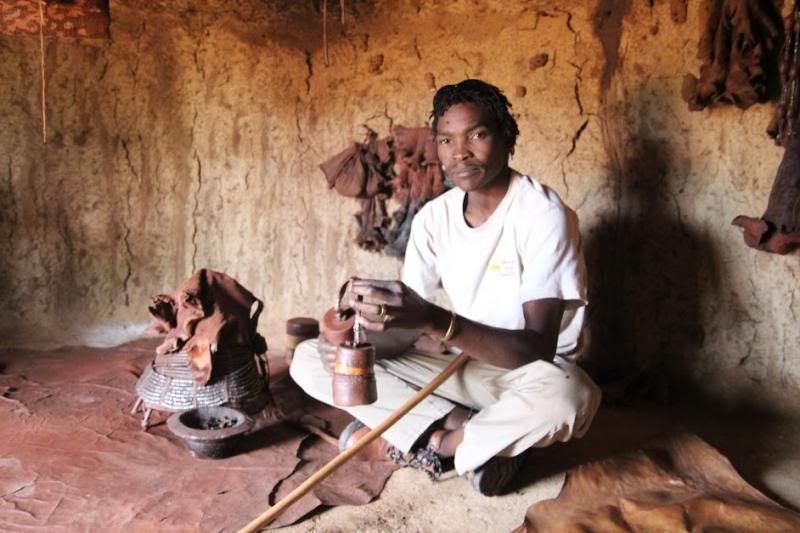 On the wall are skins worn as skirts or used for blankets.  Here is a “neck pillow” for sleeping on. The guide said that it’s surprisingly comfortable. I’ll have to take his word for it.  Upon departing the hut, we saw that the villagers had set up a small handicraft market for us. The Himba, despite living a mostly traditional lifestyle that relies on the land, do purchase some things they need from the store, so they are not untouched by the desire to make capital. They had lovely goods and I was happy to buy a few souvenirs, but I must say I was a little uncomfortable with half the village calling me over, competing for my business. I bought some bracelets and little wood carvings, spreading my purchases out between three people. I was sorry I couldn’t buy more, but that was the best I could do.  Shortly after leaving the village, we got our first look at an iconic creature whose presence we had been eagerly anticipating for days. We were absolutely thrilled!  He, however, eyed us warily and decided he didn’t want to stick around. He ambled across the road, stepped over a fence, and disappeared into the bush.  The rest of the drive was lovely, peppered with bird and animal sightings. Of course, we also enjoyed just being on the road underneath African skies.  We saw this splendid little lilac-breasted roller, a bird that was on my must-see list. I wish my photo did justice to its vivid plumage.  That evening we saw a red hartebeest, the only one of whole trip. Unfortunately, he refused to wait around for me to adjust my camera settings, so this is the best shot I got.  |
|
|
|
Post by mossie on May 23, 2013 18:42:59 GMT
Super. Super. I love the lovebirds  and your insight into the people was very thoughtful. It must be difficult for them being used as a show village. The giraffe was a bonus, the way that they walk is an education. Thanks very much |
|
|
|
Post by Deleted on May 23, 2013 19:15:09 GMT
That is a truly fantastic series of photos, but those tentacle tresses are a bit disturbing.  |
|
|
|
Post by bjd on May 23, 2013 19:28:51 GMT
The pictures of the people in the village are very good indeed.
I must add that it reminds me of a safari in Kenya when we were taken to a Masai village after the game drive. We had to pay to enter, then they all sat around colourfully while we took photos. The head guy ( a young man who spoke extremely good English) took us around, showed us his house and answered questions. At the end, we were taken to a bunch of stands where they were selling bead jewellery and things like that.
I do feel torn about it all. On the one hand, we had to pay to go into the village so I felt I had the "right" to take pictures. But indeed, its rather uncomfortable because all these people have to sell is their picturesque appearance. There isn't the same interaction as going up to someone and asking if you can take their picture.
I don't know if I'm expressing myself well, but I think mossie raises the same point in the post just above mine.
|
|
|
|
Post by Deleted on May 23, 2013 20:44:33 GMT
I want to add that the girafe crossing the road is spectacular.
I was faced with the dilemma of photographing tribal people in Vietnam. The 'dominant' Vietnamese guides seemed to think it was so normal and natural to go traipsing through the villages to take photos of their quaint eccentricities. It would have bothered me less if I had had the assurance that money was being given to these tribes for such humiliation, but I am afraid that it was just imposed upon them.
|
|
|
|
Post by htmb on May 23, 2013 22:24:28 GMT
What fantastic photos, nycgirl and boy. Awesome job of capturing the animals and people, plus a superb narrative.
|
|
|
|
Post by Deleted on May 24, 2013 11:27:23 GMT
So well captured. I especially like the giraffe pics. This really opens my eyes to another world.
|
|
|
|
Post by nycgirl on May 24, 2013 11:51:55 GMT
Thanks, everyone. I'm glad I managed to snap a photo of the giraffe but I wish I had framed it better. The second photo needs more road and less sky. Oh well, I was excited and nervous. That is a truly fantastic series of photos, but those tentacle tresses are a bit disturbing.  You must not be a fan of dreadlocks either.  I don't know if I'm expressing myself well, but I think mossie raises the same point in the post just above mine. I know what you mean and I gave the matter some thought before I decided to go. I was concerned about the tour being exploitative, or encouraging visitors to view the Himba as the "Other." After doing some reading I decided it was worth a visit because, first of all, the proceeds would go to supporting the kids, and secondly, it was an authentic village and no one was made to dress up and perform dances, etc. The Himba simply go about business as usual when tourists come to visit. Our guide stated upfront that he hoped the tour would be a cultural exchange, not just passive observing. In keeping with this goal, he taught us a few phrases, as I said, and encouraged conversation with the locals. I can't say for sure how well that goal was achieved, but I do remember the word "Okuhepa" (thank you), and I thought it was a very educational experience. Furthermore, the villagers were interested in us as well and asked us questions. My husband and I would have liked to also go on a bush walk with the San. We would have had the natural interaction that comes with doing something together, the San would have shared their expertise with us, and we would have enjoyed the great outdoors all at the same time. I believe this type of experience would have avoided the awkward, problematic situation you described. Unfortunately, we couldn't find a good tour guide. Perhaps next time. |
|
|
|
Post by bjd on May 24, 2013 12:02:12 GMT
I'm glad it worked that way, nycgirl. Actually, despite that first visit, I did have an opportunity that was interesting.
The last day in Masai Mara, the guide asked whether I would prefer to go for a walk or go on another game drive. I chose the walk and went with one of the Masai guards working there. It was interesting -- we were gone for about 2 hours -- stopped to talk with the tiny kids watching their herds of goats or cows, talked about the political situation in Kenya -- then he took me back to the village to exchange one of the necklaces I had bought the day before and which had broken immediately. So I did have a "personal" experience, off the usual track.
|
|
|
|
Post by nycgirl on May 25, 2013 3:20:45 GMT
On our way out of Namibia, we passed through a small town where I spotted this Herero woman wearing an elegant silk dress.  I soon ran into another Herero, who obligingly posed for me.  The Herero are closely related to the Himba and are a traditionally pastoral tribe. Unlike the Himba, however, they came in contact with German missionaries in the early 1900s, who convinced them to give up their "scandalous" tribal wear in favor of long dresses with multiple petticoats. Not very practical for herding animals in the desert, but the style stuck. The coordinating horn-shaped hats are the Herero's own addition, in honor of the cattle that are so important to their way of life. Here are a couple of articles that beautifully showcase more Herero styles of dress, as well as touch upon their tragic history in Namibia. www.cnn.com/2011/11/03/world/africa/namibia-victorian-fashionwww.dailymail.co.uk/news/article-2286624/The-Namibian-women-STILL-dress-like-colonists-Tribe-clings-19th-century-dress-protest-Germans-butchered-them.htmlWe said a very fond farewell to Namibia and crossed the border into Botswana. At this point, we were low on gas and out of cash, so we were desperate to find a gas station that accepted credit cards. We got our hopes up when we spotted this station from a distance...  ... but we soon saw that it was our of order.   Oh, well. Fortunately, we did eventually find a gas station and an ATM machine, which was a relief. At the station, I snapped one more photo of a regal-looking Herero woman.  All day long we drove through Botswana and made good time, even though we occasionally stopped for bird and animal sightings. As sunset approached, we were almost over the border of South Africa when we got pulled over for speeding. The cops called my husband away from the car and as they were talking to him, I anxiously watched my husband put his hands on his head for arrest. Oh no! As it turns out, though, my husband was just messing around and wanted to give us a scare (jerk). The cops had a laugh and jokingly said they were going to have to impound the car. Not funny, in my opinion. My husband bribed them with US dollars, which was all he had with him and which they were quite willing to take, and we were on our way. Lucky us, we happened to be the last catch before the cops went home that day. 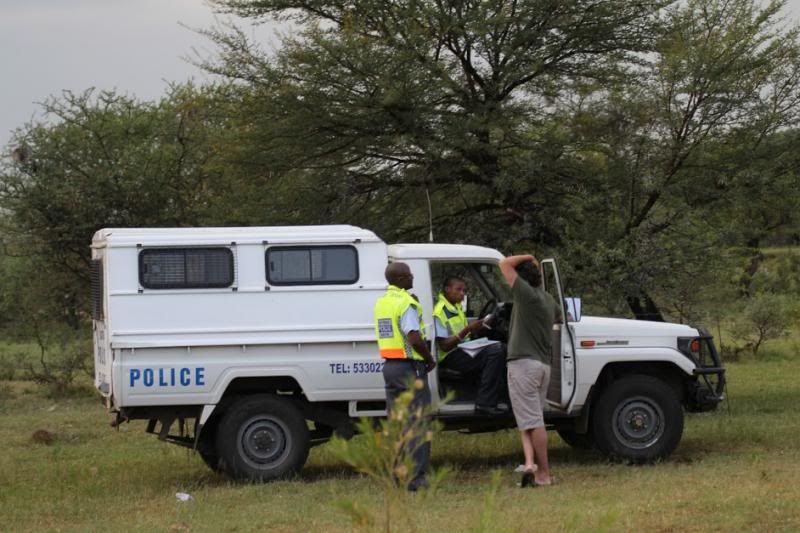 We were treated to a lovely pastel sunset right before we crossed the border. Next stop: Kruger!  |
|
|
|
Post by spindrift1 on May 25, 2013 10:47:33 GMT
Wow, nycgirl. you have brought Africa alive for me and I have immersed myself in your pictures. Those little rosy-faced lovebirds are so cute. Then the Himba - such beautiful women. Are the men just as handsome? Their skin colour is amazing. Did you find that most village people living in the bush dressed 'au naturel' rather than wearing conventional clothes? How far are the main towns? I am hoping that the Himba still live a life not influenced by western tastes. Was there a school in the village?
I simply long to visit Namibia and take my time travelling around. How long did you spend there?
|
|
|
|
Post by Deleted on May 25, 2013 11:38:14 GMT
I was looking at the photos of the Himba village again and what struck me is how finely handicrafted everything is -- necklaces, bracelets, the skins/blankets and of course the hairstyles -- and yet everything else is so primitive. It's amazing how different cultures have totally different priorities.
|
|
|
|
Post by htmb on May 25, 2013 11:51:19 GMT
Nycgirl, you certainly had a full day!
|
|
|
|
Post by nycgirl on May 25, 2013 15:27:47 GMT
Spindrift, I agree, the women and children are beautiful people. As for the men, I only saw one man there. I think the Himba and the San are the only tribes in the country who have kept a traditional lifestyle and even they, as I said, are not completely uninfluenced by Western civilization. For example, though the Himba mainly live off the land and barter to meet their needs, they also go grocery shopping for some necessities, and this means they need to earn at least a small amount of money. I believe there was a bare-bones school in the village, supported by funds generated from tours.
|
|
|
|
Post by nycboy on May 25, 2013 17:33:23 GMT
They did show us a class room in the village, it was a handmade building of tree branches with a roof.
|
|
|
|
Post by lugg on May 27, 2013 21:22:35 GMT
Really interesting additions to your thread and, as always, stunning photos.
I remember playing " elastics" as a child- similar to as you describe and the young Himba girls were playing with ropes. I wonder do many childhood games span continents ?
Fascinating to see how the hairstyles evolve as the children grew older. The jewellery is really intricate , did you see what kind of tools they used ?
The animals and birds are also fab , the giraffe superb and I think that the sky emphasises and enhances the height beautifully.
|
|
|
|
Post by nycgirl on May 28, 2013 19:50:09 GMT
Lugg, I didn't see what tools they used to make jewelry. It's too bad, I would have loved to watch them at work. As I said, they were very creative. I bought three carved bracelets from them that were made from PVC pipes. They look like bone or ivory.
|
|
|
|
Post by htmb on May 28, 2013 20:18:05 GMT
That sunset is amazingly beautiful.
|
|
|
|
Post by spindrift1 on May 28, 2013 21:32:26 GMT
nycgirl - well I guess the men were away working whilst the women and children entertained the visitors. Have you visited any other parts of Africa?  |
|
|
|
Post by nycgirl on May 29, 2013 4:25:48 GMT
I believe this village is almost entirely made up of women and children. They milk and herd the cattle, churn butter, cook, gather supplies, make things, etc.
This is my first trip to Africa. I can't wait to go back.
|
|
|
|
Post by spindrift1 on May 29, 2013 20:40:51 GMT
I feel the same way as you do!
|
|
|
|
Post by bixaorellana on Jun 2, 2013 1:09:37 GMT
There's just not enough good stuff to say about this thread! It has gorgeous photos, exotic wildlife, stunning vistas, sprightly text, but probably the coolest thing of all are all the people in it. You caught them in all their humanity, which comes through strongly despite their very different way of dressing (or not dressing) compared to most of us reading this thread.
|
|